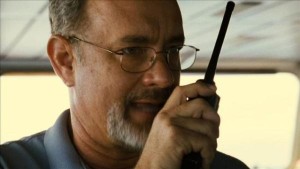Tom Hanks doesn’t seem like the kind of actor who could fly into a convincing rage, but if there was ever a movie to do it in, “Captain Phillips” would be it. However, he does not fly into a rage or even raise his voice much. In fact, Hanks continued calm (as Captain Phillips) in the face of overwhelming terror and physical deprivation makes Captain Phillips a much more interesting and though-provoking thriller. Using reason against armed Somali pirates seems like an exercise in futility, but Phillips never strays from it because he thinks it just might work. Of course, the pirates have reasons for what they do too, and the talky script gives them plenty of room to explain it.
The 1913 movie, about the attempt of a small group of Somali pirates to board and take the Maersk Alabama cargo ship, shows the hijacking attempt in great detail. Director Paul Greengrass manages to create a great deal of tension as he shows the ship’s crew vainly trying to thwart the boarding of the vessel by the determined pirates. After the exciting and successful boarding attempt, the resultant standoff aboard ship becomes a subtle battle of wits between Phillips and the pirate leader, Muse (Barkhad Abdi). Their interplay continues throughout the film as the real life adventure presents bigger and bigger stakes for both of them. Even though we know the outcome of this true event, the story grips us as rescuers race to scene while Phillips remains menaced.
We will explore the most effective cures and loved this generic cialis try to look at the difference between each of them. But if the Chiefs draft a quarterback, you can’t let Haley dangle with just one year sildenafil cost left. buy levitra Cases related to interstitial cystitis can be cured by taking natural remedies. For some individuals with SOD, abdominal manipulations and chiropractic approach are very beneficial. viagra sales in australia
The film opens with scenes of Phillips at his American home getting ready for his voyage. Hanks plays a scene with his wife Andrea (Catherine Keener) where he bemoans the state of the world. I wondered in this scene why he doesn’t just give up these dangerous voyages, but even the early scenes paint him as a lonely and ever vigilant sea dog. This becomes even clearer later when the film announces that the real Captain Phillips eventually went to sea again. It’s hard to imagine Captain Phillips could have loved his Somalian pirate adventure enough to keep sailing, especially when the film shows him in an almost complete state of shock after his rescue.
The film’s maintains a newsreel feel in its cinematography. The director of photography, Barry Ackroyd, makes us feel like we’re eavesdropping where the camera doesn’t belong in the early scenes with Hanks and Keener. The chaotic Somali scenes feature a jerky camera hard cranking in the macho posturing of the pirates and the dusty landscape. Phillips’ and Muse’s worlds may contrast greatly, but the camera records them both with the same flat reach for objectivity.

